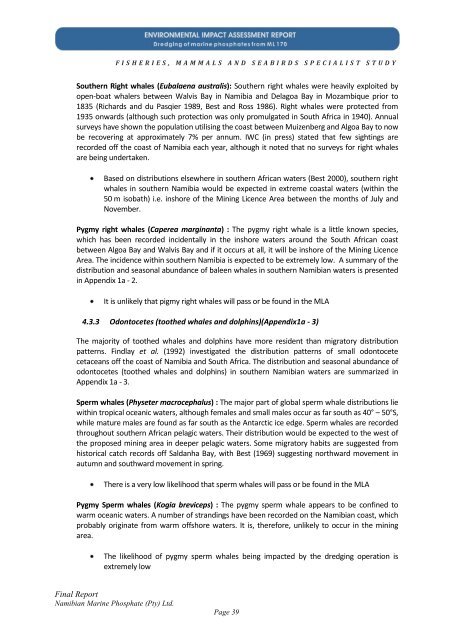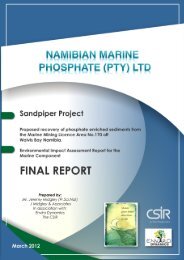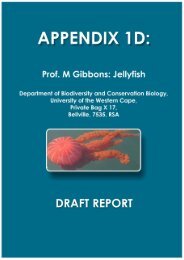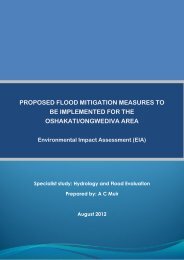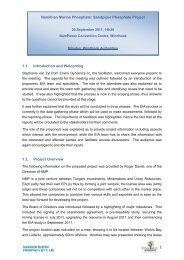Fisheries - Enviro Dynamics Namibia
Fisheries - Enviro Dynamics Namibia
Fisheries - Enviro Dynamics Namibia
You also want an ePaper? Increase the reach of your titles
YUMPU automatically turns print PDFs into web optimized ePapers that Google loves.
F I S H E R I E S , M A M M A L S A N D S E A B I R D S S P E C I A L I S T S T U D Y<br />
Southern Right whales (Eubalaena australis): Southern right whales were heavily exploited by<br />
open-boat whalers between Walvis Bay in <strong>Namibia</strong> and Delagoa Bay in Mozambique prior to<br />
1835 (Richards and du Pasqier 1989, Best and Ross 1986). Right whales were protected from<br />
1935 onwards (although such protection was only promulgated in South Africa in 1940). Annual<br />
surveys have shown the population utilising the coast between Muizenberg and Algoa Bay to now<br />
be recovering at approximately 7% per annum. IWC (in press) stated that few sightings are<br />
recorded off the coast of <strong>Namibia</strong> each year, although it noted that no surveys for right whales<br />
are being undertaken.<br />
Based on distributions elsewhere in southern African waters (Best 2000), southern right<br />
whales in southern <strong>Namibia</strong> would be expected in extreme coastal waters (within the<br />
50 m isobath) i.e. inshore of the Mining Licence Area between the months of July and<br />
November.<br />
Pygmy right whales (Caperea marginanta) : The pygmy right whale is a little known species,<br />
which has been recorded incidentally in the inshore waters around the South African coast<br />
between Algoa Bay and Walvis Bay and if it occurs at all, it will be inshore of the Mining Licence<br />
Area. The incidence within southern <strong>Namibia</strong> is expected to be extremely low. A summary of the<br />
distribution and seasonal abundance of baleen whales in southern <strong>Namibia</strong>n waters is presented<br />
in Appendix 1a - 2.<br />
It is unlikely that pigmy right whales will pass or be found in the MLA<br />
4.3.3 Odontocetes (toothed whales and dolphins)(Appendix1a - 3)<br />
The majority of toothed whales and dolphins have more resident than migratory distribution<br />
patterns. Findlay et al. (1992) investigated the distribution patterns of small odontocete<br />
cetaceans off the coast of <strong>Namibia</strong> and South Africa. The distribution and seasonal abundance of<br />
odontocetes (toothed whales and dolphins) in southern <strong>Namibia</strong>n waters are summarized in<br />
Appendix 1a - 3.<br />
Sperm whales (Physeter macrocephalus) : The major part of global sperm whale distributions lie<br />
within tropical oceanic waters, although females and small males occur as far south as 40° – 50°S,<br />
while mature males are found as far south as the Antarctic ice edge. Sperm whales are recorded<br />
throughout southern African pelagic waters. Their distribution would be expected to the west of<br />
the proposed mining area in deeper pelagic waters. Some migratory habits are suggested from<br />
historical catch records off Saldanha Bay, with Best (1969) suggesting northward movement in<br />
autumn and southward movement in spring.<br />
There is a very low likelihood that sperm whales will pass or be found in the MLA<br />
Pygmy Sperm whales (Kogia breviceps) : The pygmy sperm whale appears to be confined to<br />
warm oceanic waters. A number of strandings have been recorded on the <strong>Namibia</strong>n coast, which<br />
probably originate from warm offshore waters. It is, therefore, unlikely to occur in the mining<br />
area.<br />
The likelihood of pygmy sperm whales being impacted by the dredging operation is<br />
extremely low<br />
Final Report<br />
<strong>Namibia</strong>n Marine Phosphate (Pty) Ltd.<br />
Page 39


